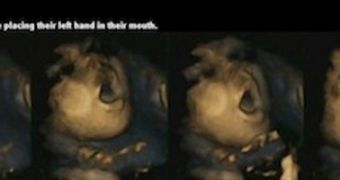Babies can anticipate touch while they are still inside their mother's womb, researchers working with Durham and Lancaster universities argue in a paper published in the journal Developmental Psychobiology.
The researchers have released a series of pictures, made available to you next to this article, which clearly show a baby opening its mouth some time before putting its hand in it.
As the researchers explain in their paper, this indicates that, rather than simply react to stimuli, babies can predict them even when they are very young.
EurekAlert tells us that, in order to determine when a baby switches from reacting to stimuli to anticipating them, the scientists monitored 15 healthy fetuses, i.e. 8 girls and 7 boys, between 24 weeks and 36 weeks of gestation.
Once every month, the researchers carried out 4D scans that allowed them to study the fetuses' behavior, the same source details.
Apparently, most of the fetuses began to open their mouths before actually touching them with their hands when their mothers were in their 36th week of pregnancy.
Interestingly enough, it was around the 36th week of gestation that the fetuses also started to touch the lower part of their face more often than they did their upper part and the sides of their head.
“Increased touching of the lower part of the face and mouth in fetuses could be an indicator of brain development necessary for healthy development, including preparedness for social interaction, self-soothing and feeding,” Dr. Nadja Reissland at Durham University said.
“What we have observed are sequential events, which show maturation in the development of fetuses, which is the basis for life after birth. The findings could provide more information about when babies are ready to engage with their environment, especially if born prematurely,” the researcher further commented on these findings.
As far as the researchers could tell, there were no differences in the behavior displayed by the boys and girls monitored as part of this investigation.

 14 DAY TRIAL //
14 DAY TRIAL //